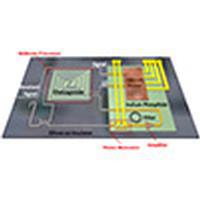Our official English website, www.x-mol.net, welcomes your feedback! (Note: you will need to create a separate account there.)
Chip-based Brillouin processing for carrier recovery in self-coherent optical communications
Optica ( IF 10.4 ) Pub Date : 2018-09-26 , DOI: 10.1364/optica.5.001191 Elias Giacoumidis , Amol Choudhary , Eric Magi , David Marpaung , Khu Vu , Pan Ma , Duk-Yong Choi , Steve Madden , Bill Corcoran , Mark Pelusi , Benjamin J. Eggleton
Optica ( IF 10.4 ) Pub Date : 2018-09-26 , DOI: 10.1364/optica.5.001191 Elias Giacoumidis , Amol Choudhary , Eric Magi , David Marpaung , Khu Vu , Pan Ma , Duk-Yong Choi , Steve Madden , Bill Corcoran , Mark Pelusi , Benjamin J. Eggleton

|
Modern fiber-optic coherent communications employ advanced, spectrally efficient modulation formats that require sophisticated narrow-linewidth local oscillators (LOs) and complex digital signal processing (DSP). Self-coherent optical orthogonal frequency-division multiplexing (self-CO-OFDM) is a modern technology that retrieves the frequency and phase information from the extracted carrier without employing a LO or additional DSP. However, a wide carrier guard is typically required to easily filter out the optical carrier at the receiver, thus discarding many OFDM middle subcarriers that limit the system data rate. Here, we establish an optical technique for carrier recovery, harnessing large-gain stimulated Brillouin scattering (SBS) on a photonic chip for up to self-CO-OFDM signals, without requiring a separate LO. The narrow SBS linewidth allows for a record-breaking small carrier guard band of in self-CO-OFDM, resulting in higher capacity than benchmark self-coherent multi-carrier schemes. Chip-based SBS-self-coherent technology reveals comparable performance to state-of-the-art coherent optical receivers while relaxing the requirements of the DSP. In contrast to on-fiber SBS processing, our solution provides phase and polarization stability. Our demonstration develops a low-noise and frequency-tracking filter that synchronously regenerates a low-power narrowband optical tone, which could relax the requirements on very-high-order modulation signaling for future communication networks. The proposed hybrid carrier filtering-and-regeneration technique could be useful in long-baseline interferometry for precision optical timing or reconstructing a reference tone for quantum-state measurements.
中文翻译:

基于芯片的布里渊处理,用于自相干光通信中的载波恢复
现代光纤相干通信采用先进的,频谱有效的调制格式,这些格式需要复杂的窄线宽本地振荡器(LO)和复杂的数字信号处理(DSP)。自相干光学正交频分复用(self-CO-OFDM)是一种现代技术,无需使用LO或其他DSP,即可从提取的载波中检索频率和相位信息。但是,通常需要较宽的载波保护装置,以轻松滤除接收器处的光载波,从而丢弃许多限制系统数据速率的OFDM中间子载波。在这里,我们建立了一种用于载流子恢复的光学技术,利用光子芯片上的大增益受激布里渊散射(SBS)达到了自CO-OFDM信号,无需单独的LO。窄的SBS线宽允许创纪录的小型载波保护带在自CO-OFDM中,与基准自相干多载波方案相比,容量更高。基于芯片的SBS自相干技术在放宽DSP要求的同时,可提供与最新相干光接收器相当的性能。与光纤SBS处理相比,我们的解决方案提供了相位和偏振稳定性。我们的演示开发了一种低噪声和频率跟踪滤波器,可同步再生低功率窄带光学音调,从而可以放宽对未来通信网络的高阶调制信令的要求。所提出的混合载波滤波和再生技术可用于长基线干涉测量中,以实现精确的光学定时或重构参考音,以进行量子态测量。
更新日期:2018-10-19
中文翻译:

基于芯片的布里渊处理,用于自相干光通信中的载波恢复
现代光纤相干通信采用先进的,频谱有效的调制格式,这些格式需要复杂的窄线宽本地振荡器(LO)和复杂的数字信号处理(DSP)。自相干光学正交频分复用(self-CO-OFDM)是一种现代技术,无需使用LO或其他DSP,即可从提取的载波中检索频率和相位信息。但是,通常需要较宽的载波保护装置,以轻松滤除接收器处的光载波,从而丢弃许多限制系统数据速率的OFDM中间子载波。在这里,我们建立了一种用于载流子恢复的光学技术,利用光子芯片上的大增益受激布里渊散射(SBS)达到了自CO-OFDM信号,无需单独的LO。窄的SBS线宽允许创纪录的小型载波保护带在自CO-OFDM中,与基准自相干多载波方案相比,容量更高。基于芯片的SBS自相干技术在放宽DSP要求的同时,可提供与最新相干光接收器相当的性能。与光纤SBS处理相比,我们的解决方案提供了相位和偏振稳定性。我们的演示开发了一种低噪声和频率跟踪滤波器,可同步再生低功率窄带光学音调,从而可以放宽对未来通信网络的高阶调制信令的要求。所提出的混合载波滤波和再生技术可用于长基线干涉测量中,以实现精确的光学定时或重构参考音,以进行量子态测量。



























 京公网安备 11010802027423号
京公网安备 11010802027423号